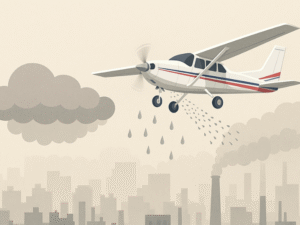Harshit Rana : The Express Pace Sensation Igniting India’s Campaign Down Under
Artificial Rain : Delhi’s Daring Experiment to Combat Deadly Smog

Artificial Rain
Artificial Rain : Delhi’s air quality index (AQI) has plummeted to hazardous levels post-Diwali, with fine particulate matter (PM2.5) choking the lungs of millions. Enter artificial rain—a weather modification technique known as cloud seeding—that promises to literally wash away the pollution. But is this high-tech hail Mary a real game-changer, or just another drop in the polluted ocean?
In this blog, we’ll dive into what artificial rain is, how Delhi is gearing up for its first trial, the science behind it, and why it’s sparking both hope and skepticism worldwide.
What Exactly is Artificial Rain?
Artificial rain, or cloud seeding, isn’t some sci-fi plot—it’s a proven meteorological hack that’s been around since the 1940s. The core idea? Humans playing rainmaker by injecting clouds with particles that encourage water droplets to form and fall as precipitation.

Here’s the simple science :-
- Target Clouds : Pilots scan for supercooled clouds (those below freezing but still liquid) using radar and weather data.
- Seeding Agents : From an aircraft or ground-based generators, they release substances like silver iodide (which mimics ice crystals), dry ice (solid CO2), or even table salt. These act as “nuclei” for moisture to cling to.
- The Cascade Effect : Tiny droplets collide and grow into raindrops heavy enough to plummet to earth.
The goal isn’t to conjure rain from thin air but to amplify what’s already brewing in the atmosphere. Success rates? Studies suggest 10-30% more precipitation in ideal conditions, though measuring exact impact remains tricky—how do you prove what wouldn’t have rained without intervention?
Globally, it’s no stranger: China deploys it for drought relief and even cleared Beijing’s skies for the 2008 Olympics. The UAE uses it to green deserts, while the U.S. has seeded clouds for over 50 years to boost snowfall in ski resorts.
Delhi’s Smog Crisis : Why Artificial Rain Now?
Delhi isn’t just polluted—it’s the world’s most polluted city, according to recent IQAir rankings. Post-Diwali fireworks, crop burning from neighboring states, and stagnant winter winds have pushed AQI above 400 in parts of the National Capital Region (NCR). That’s “severe” territory, where kids stay home, construction halts, and hospitals overflow with respiratory cases.
Enter the Delhi government’s bold move: artificial rain as an emergency detox. On October 23, 2025, a successful trial flight over Burari released seeding agents into clouds, confirming the tech’s viability. Chief Minister Rekha Gupta announced that if weather gods cooperate—with cloudy skies forecast for October 28-30—the capital could see its first man-made downpour on October 29.
“This is a necessity,” Gupta stated, emphasizing how the rain would scrub PM2.5 and PM10 particles from the air, potentially slashing AQI by 20-30%. The operation, costing around ₹50 lakh per flight, involves IIT Kanpur experts and aircraft from the Indian Air Force. It’s not just about today—future plans include regular seeding during peak pollution months.
Social media is buzzing. On X (formerly Twitter), users like @IndianTechGuide hailed it as a “tech triumph,” while farmers voiced concerns about untimely rains damaging fresh wheat crops. Vision IAS shared a video breakdown, questioning if cloud seeding can truly “clear the air” long-term.
The Promise and Perils of Cloud Seeding
The Upsides
- Instant Relief : A single shower can trap pollutants in raindrops, depositing them on the ground for cleanup. In past UAE trials, it reduced urban dust by up to 40%.
- Multi-Purpose : Beyond pollution, it aids agriculture in drought-hit areas and stabilizes reservoirs for hydropower.
- Eco-Friendly Edge : Compared to chemical foggers or water sprinklers, it’s targeted and uses minimal agents.

The Challenges
- Weather Lottery : No clouds, no rain. If October 29 stays dry, it’s back to square one.
- Unproven in Urban Chaos : Delhi’s mega-pollution soup might overwhelm the washout—experts warn it could redistribute toxins rather than eliminate them.
- Environmental Risks : Silver iodide is low-toxicity, but overuse raises questions about soil and water contamination. Plus, who gets the rain? Downwind areas might flood while upstream stays parched.
- Cost vs. Cure : At ₹50 lakh a pop, it’s pricey. Critics argue it’s a band-aid when root fixes—like stricter stubble burning bans or electric vehicle mandates—lag behind.
A Guardian report captured the skepticism: “India trials Delhi cloud seeding to clean air in world’s most polluted city,” but experts like those at Context News note it’s no silver bullet for the “airpocalypse.”
| Aspect | Potential Impact in Delhi | Global Precedent |
| Pollution Reduction | 20-30% AQI drop per event | UAE: 40% dust cut |
| Cost | ₹50 lakh/flight | China: $100M/year program |
| Success Rate | 50-70% (weather-dependent) | U.S.: 10-15% precip boost |
| Risks | Chemical residue, uneven rain | Minimal, but monitoring needed |
A Global Lifeline or Local Gimmick?
Artificial rain shines brightest in water-scarce spots. Australia’s “Rainmaker” project revived farms during the Millennium Drought, while California’s seeding fights wildfires by enhancing snowpack. In India, Maharashtra and Tamil Nadu have toyed with it for monsoons, but Delhi’s urban twist makes it pioneering.
Yet, as NDTV’s aerial report from the trial plane reveals, the real test is integration: Pair seeding with GRAP (Graded Response Action Plan) stages, green corridors, and public transport pushes. Without that, it’s like mopping the floor during a flood.
Also Read This : Mappls : India’s Indigenous Navigation Revolution Developed by Indian Company MapmyIndia
Clearing the Air : What’s Next for Delhi?
As October 29 approaches, all eyes are on the skies. Will artificial rain deliver a breath of fresh air to 30 million Delhiites? Early signs are promising—the Burari trial showed chemical dispersion without a hitch. But true victory lies in prevention: Reforestation, clean energy, and cross-state cooperation.


